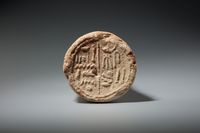
Bowl with fish and lotuses
An item at Metropolitan Museum of Art
This charming little bowl is made in brilliant blue faience and decorated in black paint, including a thin black rim. The exterior of the shallow bowl is nicely rounded and shows an open lotus flower in top view with its pointed petals spreading across the surface. The bowl’s interior features a tilapia with two lotus stems emerging from its mouth. They extend to opposite sides of the bowl and end in closed buds. The fish as well as the open and closed lotus flowers on both sides of the vessel symbolize regeneration and rebirth. The lotus opens and closes with the sunlight which was seen as a cycle of birth, death, and rebirth. The curious behavior of the tilapia to carry its egg in its mouth until they hatch, connected this fish with the power of life and regeneration. Additionally, the blue color of the faience contributed to the symbolism of this piece as it relates to the Nile water, which was life-bringing as well. Such decorated faience bowls, filled with potent symbols of regeneration, were used as grave goods as well as temple offerings for the goddess Hathor.
Egyptian Art
An exhibit at Metropolitan Museum of Art
The Met collection of ancient Egyptian art consists of approximately 30,000 objects of artistic, historical, and cultural importance, dating from about 300,000 BCE to the 4th century CE. A signifcant percentage of the collection is derived from the Museum's three decades of archaeological work in Egypt, initiated in 1906 in response to increasing interest in the culture of ancient Egypt.




